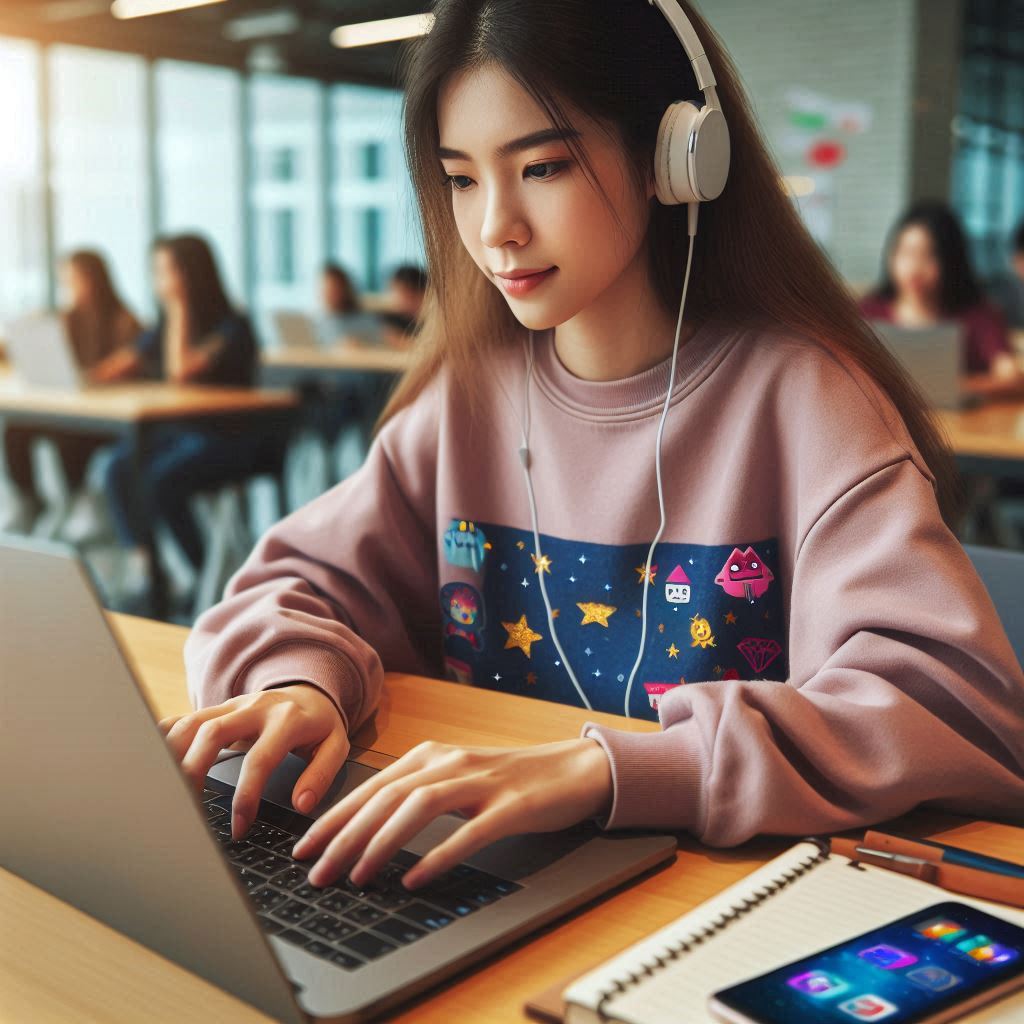Introduction
Gamified learning platforms integrate game mechanics into educational experiences.
These platforms transform traditional learning into interactive and stimulating environments.
They utilize rewards, challenges, and competition to motivate students.
By incorporating elements like points, badges, and leaderboards, these tools make learning enjoyable.
Gamified Learning Platforms
Gamified learning platforms are software applications designed to enhance student engagement through game-based mechanics.
These platforms encourage participation by making educational tasks feel like games.
They often include quizzes, puzzles, and challenges that provide instant feedback.
Users can track their progress and set personal goals.
This setup motivates students to achieve success through gameplay.
Importance of Student Engagement in the Learning Process
Student engagement plays a vital role in effective learning.
Engaged students are more likely to participate actively in their education.
They retain information better and develop critical thinking skills.
Research shows that when students feel involved, they perform better academically.
Additionally, engagement fosters a positive attitude towards learning.
It can lead to increased persistence and resilience in overcoming academic challenges.
Overview of How Gamified Learning Addresses Engagement Challenges
Gamified learning platforms effectively address common engagement challenges.
They break down complex subjects into manageable, game-like tasks.
This approach reduces anxiety and encourages exploration.
By infusing education with game elements, these platforms create a sense of achievement.
Students feel rewarded for their efforts, enhancing their motivation.
Moreover, they promote collaboration through team-based challenges.
Peer interaction fosters social skills and creates a sense of community.
Ultimately, gamified learning platforms make education more accessible and enjoyable, leading to a more engaged learning experience.
The Psychology Behind Gamification
Understanding Intrinsic and Extrinsic Motivation
Gamification taps into two main types of motivation: intrinsic and extrinsic.
- Intrinsic Motivation: This type arises from internal satisfaction. For example, learning a new skill because it sparks curiosity or personal interest.
- Extrinsic Motivation: This comes from external rewards. Examples include earning badges, certificates, or points to compete on leaderboards.
Gamified learning environments leverage both motivations effectively.
Educators design tasks that fulfill students’ intrinsic needs while giving them the incentive of extrinsic rewards.
When students engage with these platforms, they often experience a blend of both motivations.
The combination of these two motivations enhances overall engagement.
Research shows that when students find joy in learning, they tend to achieve better outcomes.
A successful gamified learning platform balances intrinsic and extrinsic elements.
Wanting to do well because of personal satisfaction alongside external recognition creates a synergistic effect.
How Game Elements Foster a Growth Mindset
Game design incorporates elements that encourage a growth mindset.
- Challenges: Games present challenges that require effort and persistence. Students learn to embrace difficulties rather than fearing them.
- Feedback: Instant feedback is a cornerstone of gaming. Students receive immediate responses that help them understand their progress.
- Progression: Games often have levels or stages. This structure helps students see how their skills improve over time.
The concept of “failure” integrates seamlessly into games.
In gamified learning, failure becomes a part of the journey.
Students face setbacks, learn from mistakes, and reattempt tasks.
We Design & Develop Websites, Android & iOS Apps
Looking to transform your digital presence? We specialize in creating stunning websites and powerful mobile apps for Android and iOS. Let us bring your vision to life with innovative, tailored solutions!
Get Started TodaySuch experiences frame failure as an opportunity to grow.
The gamified platforms create a non-threatening environment where students feel comfortable taking risks.
When they approach challenges with this mindset, they often develop resilience.
Examples of Psychological Theories Related to Gamified Learning
Several psychological theories align well with gamified learning.
These theories explain how game mechanics can enhance student engagement.
- Self-Determination Theory (SDT): This theory emphasizes the importance of autonomy, competence, and relatedness.
Students feel more engaged when they have control over their learning and can relate to peers. - Flow Theory: This concept highlights the importance of balancing challenge and skill. When students face appropriately challenging tasks, they enter a state of flow.
This state enhances focus and creativity. - Social Learning Theory: This theory underscores the significance of social interactions. Gamified platforms often enable collaboration among students, fostering a collaborative learning ethos.
The integration of these theories into gamified learning environments creates a richer experience.
For example, when students work together in teams, they learn collaboratively.
The combination of competition and collaboration enhances the overall learning experience.
Designing Engaging Gamified Learning Experiences
To implement gamification effectively, platforms must focus on designing engaging experiences.
- Clear Objectives: Learning objectives must be clear. Students should know what they need to achieve at each stage.
- Immersive Storytelling: Incorporating storytelling can make learning more engaging. Narratives capture students’ attention and keep them invested in their progress.
- Reward Systems: Effective reward systems encourage participation. Badges and points motivate students to complete tasks and compete.
- Variety of Challenges: Offering diverse challenges keeps the learning experience fresh. Variety prevents monotony and encourages continuous engagement.
- User Feedback: Collecting feedback from students is crucial. This input can guide future improvements and adaptations of the platform.
The best gamified platforms prioritize user engagement.
They create dynamic environments that inspire students to explore and learn.
Case Studies of Successful Gamified Learning Platforms
The impact of gamification is evident in successful case studies.
Numerous platforms illustrate how gamified learning has transformed education.
- Kahoot: This platform offers game-based quizzes that enhance learning engagement. Teachers use it to create interactive lessons that students enjoy.
- Classcraft: This platform gamifies classroom management. Students become characters in a game, where their behavior affects gameplay.
- Duolingo: This language learning app incorporates gamification. Users earn points, levels, and rewards, maintaining high engagement levels.
Each of these platforms shows how gamification can elevate traditional learning methods.
The success of these platforms demonstrates the potential of gamified learning experiences.
The psychology of gamification reveals insightful aspects of learning motivation.
Intrinsic and extrinsic motivations work together to enhance engagement.
Concepts such as growth mindset, feedback, and community further support the development of effective learning experiences.
By understanding the psychological principles behind gamification, educators can create meaningful learning environments.
Such environments not only engage students but also equip them with necessary skills.
Ultimately, gamified platforms represent an innovative approach to learning, ensuring that education remains dynamic and engaging.
Read: Predictive Analytics in Education: Forecasting Student Success with Data
Key Features of Gamified Learning Platforms
Gamified learning platforms employ unique features to engage students effectively.
These platforms blend educational content with gaming elements.
The right combination captivates learners and enhances their educational experience.
Below, we explore key features that make these platforms effective.
Point systems and leaderboards for competition
Point systems actively engage learners in a competitive environment.
Students earn points by completing tasks, quizzes, or achieving learning milestones.
This system encourages continuous participation as learners aim to accumulate more points.
- Engagement: Points motivate students to participate and try their best.
- Competition: Leaderboards display top performers, fostering a spirit of competition.
- Goal-setting: Clear point thresholds help students set achievable goals.
- Peer interaction: Leaderboards encourage social interaction within the learning community.
The competition created by point systems and leaderboards boosts student morale.
It also encourages consistent effort, helping students stay focused on their learning journey.
Badges and rewards for achievements
Badges act as visual representations of accomplishments in gamified platforms.
Students receive badges for completing tasks, mastering skills, or reaching specific goals.
These badges provide a sense of achievement.
- Recognition: Badges recognize students’ efforts and progress.
- Motivation: Seeing earned badges motivates students to pursue more achievements.
- Customization: Some platforms allow students to display earned badges on profiles.
- Social sharing: Students can share their badges on social media, enhancing pride in accomplishments.
Badges and rewards create a motivating environment.
We Design & Develop Websites, Android & iOS Apps
Looking to transform your digital presence? We specialize in creating stunning websites and powerful mobile apps for Android and iOS. Let us bring your vision to life with innovative, tailored solutions!
Get Started TodayThey encourage learners to strive for excellence and take ownership of their learning process.
Storylines and quests to enhance immersion
Engaging storylines draw students into the learning experience.
Crafting narratives around educational content immerses learners in meaningful contexts.
Stories can make subjects like history or science more relatable and exciting.
- Contextual learning: Storylines embed lessons in real-world scenarios.
- Curiosity: Quest-driven learning stimulates curiosity and exploration.
- Increased retention: Narratives help students remember concepts through emotional connections.
- Identity formation: Students can identify with characters and scenarios, enhancing engagement.
Integrating storylines transforms ordinary learning into an adventure.
This immersive experience keeps students engaged and excited to learn.
Real-time feedback and performance tracking
Immediate feedback plays a critical role in gamified learning.
Real-time assessments allow students to understand their mistakes right away.
This responsiveness helps learners correct their errors and improve.
- Timely insights: Students receive instant feedback, aiding their understanding of concepts.
- Progress monitoring: Learners can track their performance over time, observing their growth.
- Motivational boosts: Positive feedback reinforces good performance, encouraging further efforts.
- Personalized learning: Feedback helps tailor the learning experience to individual needs.
The incorporation of real-time feedback is vital.
It fosters continuous improvement and keeps learners engaged throughout their educational journey.
In summary, gamified learning platforms incorporate several key features to enhance student engagement.
These elements work synergistically to create an exhilarating learning environment.
Students experience a blend of competition, recognition, storytelling, and immediate feedback.
This comprehensive approach to learning engages students in ways traditional methods often cannot.
As educational institutions embrace technology, gamified platforms become increasingly prevalent.
By focusing on these key features, educators can harness the potential of gamification.
The result is a more engaging and effective learning experience for students of all ages.
It’s essential for educators to explore these features and implement them thoughtfully.
Doing so can revolutionize how students learn and interact with educational content.
Read: Blockchain Technology for Securing Academic Credentials and Certifications
Benefits of Gamified Learning for Students
Gamified learning platforms offer students various advantages.
They captivate students’ attention and enhance their educational experience significantly.
In this section, we explore the essential benefits of these platforms.
Increased Motivation and Participation
One of the primary benefits of gamified learning is the increased motivation among students.
Traditional educational methods often fail to engage students fully.
However, integrating game elements can turn learning into an enjoyable and rewarding experience.
- Engaging Content: Gamified platforms incorporate interactive elements, such as quizzes and challenges, that make learning enjoyable.
- Instant Feedback: Students receive immediate feedback on their performance, which encourages them to improve continuously.
- Reward Systems: Points, badges, and leaderboards motivate students to participate actively in their learning journey.
- Increased Attendance: Gamification encourages students to attend classes regularly, knowing that participation is essential to their success.
As students see their progress reflected in their awarded points or badges, their inner motivation strengthens.
This progress creates a sense of ownership over their learning.
Consequently, students become more invested in their education, leading to better academic outcomes.
Enhanced Critical Thinking and Problem-Solving Skills
Gamified learning platforms often present challenges that require critical thinking.
By solving these problems, students enhance their analytical abilities.
Learning through games encourages students to approach challenges differently.
- Real-World Scenarios: Many gamified platforms simulate real-world challenges, requiring students to apply knowledge practically.
- Multiple Solutions: Gamification often allows for multiple pathways to solve problems, fostering creative thinking.
- Time Management: Many games impose time limits, encouraging students to think quickly and make decisions efficiently.
- Risk-Taking: Students learn to take calculated risks, an essential attribute for effective problem-solving.
As students engage in these problem-solving activities, they develop their cognitive skills.
This critical thinking enhances their ability to analyze situations effectively, contributing to their overall academic success.
We Design & Develop Websites, Android & iOS Apps
Looking to transform your digital presence? We specialize in creating stunning websites and powerful mobile apps for Android and iOS. Let us bring your vision to life with innovative, tailored solutions!
Get Started TodayAdditionally, the skills gained through these challenges are transferable to various areas of life.
Opportunity for Personalized Learning Experiences
Every student learns differently.
Gamified learning platforms address this diversity through personalized experiences.
These platforms adapt the content and difficulty level based on individual student progress.
- Adaptive Learning: Many gamified platforms provide personalized learning paths that adjust according to each student’s performance.
- Tailored Feedback: Students receive feedback that speaks to their unique needs, helping them focus on areas for improvement.
- Pacing Control: Gamification allows students to learn at their own pace, promoting a better understanding of the material.
- Variety of Content: Different formats, such as simulations, videos, and quizzes, cater to various learning styles.
This personalized approach not only enhances engagement but also allows for deeper learning.
Students can spend more time on challenging topics and breeze through material they grasp swiftly.
Furthermore, personalized learning fosters a sense of accomplishment that encourages students to persevere.
Building Collaboration and Social Skills Through Multiplayer Options
Many gamified learning platforms integrate multiplayer features.
These features promote collaboration among students, building essential social skills.
Students interact, communicate, and work together towards a common goal.
- Teamwork: Multiplayer games teach students the value of teamwork, as they must collaborate to succeed.
- Communication Skills: Engaging with peers enhances verbal and non-verbal communication, which is crucial in today’s world.
- Conflict Resolution: Group challenges often lead to disagreements, helping students learn to resolve conflicts amicably.
- Networking Opportunities: These platforms connect students from different backgrounds, promoting diverse interactions.
By working together on these challenges, students develop stronger relationships.
They learn how to appreciate different perspectives, making them more well-rounded individuals.
Additionally, these interactions can lead to friendships that extend beyond the classroom.
In fact, gamified learning platforms significantly enhance students’ educational experiences.
By increasing motivation, fostering critical thinking, providing personalized learning, and building collaboration skills, these platforms create comprehensive learning environments.
As educational institutions continue to adopt this innovative approach, students worldwide can benefit greatly from the engaging nature of gamified learning.
Read: Virtual Reality Classrooms: The Future of Interactive Distance Learning

Case Studies of Successful Gamified Learning Platforms
Overview of Popular Platforms
Gamified learning platforms have transformed educational experiences.
They engage students in interactive ways.
Here are three notable examples:
- Kahoot! – A game-based learning platform that encourages student participation through quizzes.
- Classcraft – A role-playing game that gamifies classroom behavior and academic engagement.
- Duolingo – A language-learning app that utilizes gamification to motivate users through badges and levels.
Analysis of Their Features and Success Stories
Each platform presents unique features that enhance learning.
They demonstrate significant success in various educational contexts.
Kahoot!
Kahoot! engages users by turning quizzes into competitive games.
Users create and answer questions in real-time.
Teachers can customize quizzes to align with their lesson plans.
This interactivity promotes energetic classroom discussions.
Benefits of Kahoot! include:
- Instant feedback: Students receive immediate scores and can review answers.
- Accessibility: Students can join games via smartphones or tablets.
- Collaboration: Kahoot! fosters teamwork as students often play in groups.
Success Story: In a 2020 study, an elementary school reported a 30% increase in test scores after introducing Kahoot! into their curriculum.
Classcraft
Classcraft takes a different approach to gamification.
It turns classroom management into a game.
Students create characters and earn points for positive behaviors.
This interaction improves engagement and accountability.
Key features include:
- Role-playing elements: Students embody characters that affect group dynamics.
- Quest system: Challenges align with academic content, enhancing learning relevance.
- Real-time feedback: Educators can monitor student activities and interactions easily.
Success Story: A middle school in Canada reported an 80% increase in attendance after integrating Classcraft into their culture.
Students felt invested in their learning experience.
We Design & Develop Websites, Android & iOS Apps
Looking to transform your digital presence? We specialize in creating stunning websites and powerful mobile apps for Android and iOS. Let us bring your vision to life with innovative, tailored solutions!
Get Started TodayDuolingo
Duolingo revolutionizes language learning through gamification.
The app uses bite-sized lessons and engaging animations.
Users earn points for completing tasks, enhancing motivation.
Core features include:
- Daily streaks: Users receive reminders to practice regularly, promoting consistency.
- Variety of exercises: The app includes listening, speaking, and writing tasks for comprehensive practice.
- Community features: Users can challenge friends or join group challenges.
Success Story: Duolingo reports that users who engage with the app regularly perform better than traditional language learners.
Students often feel more confident in their skills.
Testimonials from Educators and Students
Educators and students provide valuable insights into these platforms.
Their testimonials highlight the effectiveness of gamified learning.
Kahoot!
One teacher notes, “Kahoot! has transformed my classroom.
Students love the excitement of competition. They show up eager to learn.”
A student adds, “I feel more involved when playing Kahoot! It’s fun to answer questions with my friends.”
Classcraft
An educator shares, “Classcraft makes behavior management engaging.
Students are more likely to participate positively.”
A student states, “Playing as a character motivates me.
I want to earn points for my team and not let them down.”
Duolingo
A language teacher mentions, “Duolingo allows students to learn at their own pace.
They enjoy tracking their progress.”
A student remarks, “It feels like playing a game. I forget I’m studying, but I’m really learning a lot.”
These case studies illustrate the power of gamified learning platforms.
Their engaging features enhance student interaction and motivation.
Educators can implement these tools to create dynamic learning environments.
Gamified platforms like Kahoot!, Classcraft, and Duolingo demonstrate tangible benefits.
Their success stories and testimonials showcase positive impacts on students and educators alike.
As technology continues to evolve, these platforms will remain key players in transforming education.
Read: AI-Driven Assessment Tools for Automated Grading and Feedback
Challenges and Limitations of Gamified Learning
Gamified learning platforms offer exciting opportunities to engage students but also come with challenges.
Understanding these challenges helps educators design effective learning experiences.
Below, we explore four significant issues faced by gamified learning platforms.
Risk of Overemphasis on Competition
While competition can motivate students, it often leads to unintended consequences.
The drive to outperform peers may overshadow collaborative learning.
Students might focus solely on winning, neglecting deeper understanding of content.
This competitive nature can create stress among learners.
Some may feel demotivated if they cannot keep up with their peers.
The risk of fostering a “winner-takes-all” mindset is significant.
Here’s a breakdown of the potential downsides of excessive competition:
We Design & Develop Websites, Android & iOS Apps
Looking to transform your digital presence? We specialize in creating stunning websites and powerful mobile apps for Android and iOS. Let us bring your vision to life with innovative, tailored solutions!
Get Started Today- Increased Anxiety: Academic pressure rises when students compete against each other.
- Reduced Collaboration: Competitive environments often discourage teamwork and sharing.
- Disengagement: Students may disengage if they feel they cannot win.
- Negative Self-esteem: Those consistently losing may develop low self-confidence.
To mitigate these risks, educators should incorporate elements of collaboration into gamified experiences.
Balancing competition with teamwork can help create a supportive environment for all learners.
Balancing Gameplay with Educational Content
Successful gamified platforms strike a balance between entertainment and education.
However, many platforms struggle to maintain this balance effectively.
When gameplay overshadows educational content, learning objectives suffer.
Students may become so immersed in gaming that they forget why they are engaged in the activity.
This can dilute the educational value of the platform.
Consider these essential factors for balancing gameplay and education:
- Clear Learning Objectives: Establish clear educational goals tied to gameplay mechanics.
- Integration of Content: Ensure game mechanics reinforce core learning concepts throughout.
- Feedback Mechanisms: Provide frequent and constructive feedback on learning progress.
- Content Relevance: Use relevant and relatable scenarios to maintain student interest.
Educators must ensure that game mechanics do not distract from learning.
Instead, these features should enhance the educational experience and engage students effectively.
Accessibility and Inclusivity Concerns
Another challenge in gamified learning platforms is ensuring accessibility and inclusivity.
Not all students have equal access to technology, which can widen the learning gap.
A lack of accessibility can result from socioeconomic factors, disabilities, or language barriers.
Therefore, it is essential for platforms to cater to diverse learner needs.
To improve inclusivity, consider these steps:
- Universal Design: Implement principles of universal design for learning to accommodate different learning preferences.
- Multi-language Support: Provide content in multiple languages to cater to non-native speakers.
- Adaptive Technology: Incorporate adaptive technologies for students with disabilities.
- Device Compatibility: Ensure compatibility across various devices to enhance accessibility.
Fostering an inclusive environment broadens educational horizons.
It allows all students to engage with the learning material equally.
Platforms that neglect these considerations risk alienating a portion of their audience.
Need for Ongoing Assessment and Adaptation of the Learning Platform
Gamified learning platforms necessitate continuous assessment and adaptation.
As technology evolves, so should the platform features.
Educators must analyze user interaction and learning outcomes to make necessary adjustments.
Neglecting this iterative process can lead to outdated content and disengaged learners.
Here are some critical aspects of ongoing assessment and adaptation:
- User Feedback: Regularly collect and implement user feedback to improve the platform.
- Performance Metrics: Monitor performance metrics to identify areas where students struggle.
- Curriculum Updates: Align content updates with current educational standards and research.
- Technology Integration: Incorporate emerging technologies to enhance user experiences.
By routinely assessing and adapting the platform, educators can ensure that the learning experience remains relevant and impactful.
This ongoing commitment to improvement fosters deeper engagement among learners.
In general, gamified learning platforms hold great potential for engaging students.
However, awareness of their challenges is crucial for success.
Educators should strive to balance competition with collaboration, gameplay with educational content, and inclusivity with ongoing adaptation.
By addressing these challenges, we pave the way for more effective and engaging learning environments that benefit all students.
Future Trends in Gamified Learning
Advances in Technology
Technology continually evolves, shaping the landscape of gamified learning.
Among these advancements, Augmented Reality (AR) and Virtual Reality (VR) stand out.
These technologies elevate immersive experiences, enhancing engagement among students.
For instance, AR overlays digital information onto the real world.
This integration fosters interactive explorations, making lessons more dynamic.
Meanwhile, VR creates entirely virtual environments.
We Design & Develop Websites, Android & iOS Apps
Looking to transform your digital presence? We specialize in creating stunning websites and powerful mobile apps for Android and iOS. Let us bring your vision to life with innovative, tailored solutions!
Get Started TodayStudents can explore historical sites, distant planets, or intricate biological systems.
Such experiences deepen understanding and retention.
They make complex subjects more tangible and relatable.
Artificial Intelligence (AI) is another game changer in education.
AI can personalize learning experiences based on individual student needs.
By using data analytics, AI identifies strengths and weaknesses.
This approach tailors content to boost student performance.
Moreover, AI-driven platforms can adapt challenge levels in real-time.
If a student excels, the platform increases difficulty.
Conversely, if a student struggles, it provides additional support.
This dynamic adjustment maintains engagement without overwhelming learners.
Predictions for the Evolution of Gamified Learning Platforms
The future of gamified learning platforms looks promising, with several notable predictions.
First, more institutions will adopt gamified approaches.
Educators recognize the importance of engagement in learning, driving this trend.
Second, platforms will increasingly incorporate storytelling elements.
Narratives can captivate students’ attention.
They also provide context, helping students relate to the material.
Enhanced storytelling promotes emotional connections with content, making it memorable.
Third, as technology improves, user interfaces will become more intuitive.
Gamified learning platforms will prioritize user experience.
This focus will ensure that barriers to entry are minimal.
Consequently, more students will engage with these platforms.
Fourth, the integration of social features will gain momentum.
Collaborative challenges will allow students to work together.
This teamwork fosters communication skills and enhances problem-solving capabilities.
Finally, data privacy and security will emerge as critical concerns.
With increased data collection through gamified platforms, protecting student information becomes paramount.
Developers will need to prioritize secure systems while maintaining engagement.
Potential for Integrating Gamification into Traditional Curricula
Schools can achieve significant benefits by integrating gamification into existing curricula.
First, gamified elements can transform mundane lessons into engaging experiences.
Traditional lectures can quickly become interactive storylines or challenges.
Second, gamification can foster a growth mindset among students.
When students face challenges, they learn to persist.
They can embrace failures as learning opportunities, promoting resilience.
Third, assessment methods can evolve through gamified systems.
We Design & Develop Websites, Android & iOS Apps
Looking to transform your digital presence? We specialize in creating stunning websites and powerful mobile apps for Android and iOS. Let us bring your vision to life with innovative, tailored solutions!
Get Started TodayInstead of standard tests, real-time assessments can measure understanding.
Students can demonstrate knowledge through game-based activities, making evaluations less intimidating.
Fourth, personalized learning paths will become more common.
Educators can tailor gamified experiences based on student preferences and learning speeds.
This customization supports diverse learning needs.
Finally, integrating gamification can facilitate ongoing feedback.
Immediate feedback helps students correct mistakes and understand concepts better.
As they progress through challenges, they receive guidance, ensuring growth.
The evolution of gamified learning platforms signifies a shift in educational paradigms.
Emerging technologies like AR, VR, and AI lead this transformation.
They enhance engagement and personalization in learning experiences.
As we anticipate future trends, the integration of gamification into traditional curricula becomes essential.
This blending of methodologies promises to enrich learning experiences for students.
By embracing these innovations, we prepare students for an interactive and dynamic future.
Conclusion
Recap of the importance of gamified learning platforms
Gamified learning platforms capture students’ attention and enhance their motivation.
These platforms use game elements to transform mundane tasks into engaging challenges.
They encourage active participation and foster a sense of achievement.
By integrating rewards and feedback, these systems support skill development effectively.
As students progress, they build persistence and resilience.
This enriching experience contributes significantly to their academic growth and personal development.
Encouragement for educators to explore gamified solutions
Educators should actively seek out gamified learning solutions.
These methods provide exciting ways to engage students of various ages and backgrounds.
Implementing game-based strategies can make lessons more dynamic.
Educators have the power to create a more interactive learning environment.
Such platforms can also cater to diverse learning styles, addressing individual needs.
By experimenting with these tools, teachers can ignite passion for learning in their students.
Call to action for further research and development in the field of gamification in education
The field of gamification in education warrants further exploration and innovation.
Researchers and developers should collaborate to create more effective learning tools.
By studying successful case studies, professionals can refine existing platforms.
Investing in research will unveil new techniques to enhance engagement.
It is crucial to evaluate the impact of gamified solutions on educational outcomes continually.
Therefore, commitment to innovation will support educators in providing meaningful learning experiences.
Before You Go…
Hey, thank you for reading this blog post to the end. I hope it was helpful. Let me tell you a little bit about Nicholas Idoko Technologies.
We help businesses and companies build an online presence by developing web, mobile, desktop, and blockchain applications.
We also help aspiring software developers and programmers learn the skills they need to have a successful career.
We Design & Develop Websites, Android & iOS Apps
Looking to transform your digital presence? We specialize in creating stunning websites and powerful mobile apps for Android and iOS. Let us bring your vision to life with innovative, tailored solutions!
Get Started TodayTake your first step to becoming a programming expert by joining our Learn To Code academy today!
Be sure to contact us if you need more information or have any questions! We are readily available.
Put Your Tech Company on the Map!
Get featured on Nicholas Idoko’s Blog for just $200. Showcase your business, boost credibility, and reach a growing audience eager for tech solutions.
Publish Now










